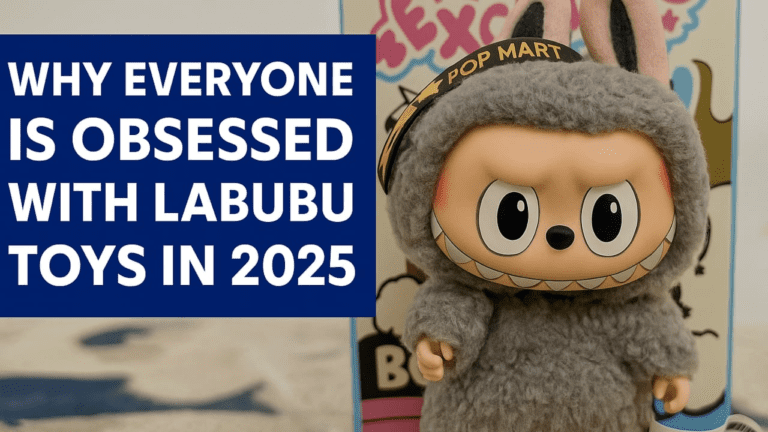In a world where childhood nostalgia blends with high fashion and viral social media trends, a wide-eyed bunny-eared creature has captured the imagination of millions. Its name? Labubu—and it’s not your typical toy.
Originally created by Hong Kong artist Kasing Lung and produced by Chinese designer toy giant Pop Mart, Labubu started as a niche collectible in Asia. But in 2025, it exploded into a full-blown global craze, redefining what it means to “play.”
Across Paris, Seoul, Los Angeles, and Sydney, long lines form outside Pop Mart stores, fans huddle around TikTok live streams, and influencers show off their newest finds like precious gemstones. But what exactly is Labubu—and why can’t anyone get enough?
The Unlikely Star: Ugly-Cute and Hugely Viral
Labubu isn’t traditionally cute. With jagged teeth, furrowed brows, and quirky outfits, the character straddles the line between adorable and creepy. That tension—what Gen Z calls “ugly-cute”—is part of its mass appeal.
Available primarily through blind-box formats, each Labubu toy is a mystery until opened. Variants include holiday editions, fantasy costumes, and even glow-in-the-dark versions. The thrill of the surprise, plus the scarcity of limited editions, has created a feverish collector’s market. Some ultra-rare Labubus have resold for thousands of dollars online.
But it wasn’t until 2025 that Labubu made the jump from cult favorite to pop culture phenomenon. The turning point? Fashion icons and A-listers.
Rihanna, TikTok, and the Birth of a Trend
In February, Rihanna was spotted leaving a fashion show in Milan with a tiny Labubu charm clipped to her handbag. The photo went viral, sparking a flood of celebrity sightings—from Dua Lipa’s shelf full of them to BLACKPINK’s Lisa posing with a metallic edition on Instagram.
Soon after, TikTok creators began filming “unboxing hauls” and “Labubu hunting” adventures. Millions of views followed, and the hashtag #Labubu trended globally. From New York to Bangkok, teens and adults alike began hunting for the toy like it was gold.
“It’s like a dopamine hit,” says Emily Zhang, a 23-year-old collector from Singapore. “You don’t know what you’ll get, but you have to try. It’s playful and exciting—and somehow comforting.”
The psychology behind the appeal is no accident. Pop Mart’s strategy leverages scarcity, surprise, and emotional reward—hallmarks of what marketers call “dopamine retail.” It’s a brilliant blend of psychology and commerce.
The Rise of the “Kidult” Economy
Labubu isn’t alone in the adult toy boom. In 2025, nearly one-third of global toy sales come from grown-ups—many buying for themselves.
It’s a movement called the “kidult” trend, where adults seek joy, nostalgia, and self-expression through collectibles, plushies, and even LEGOs. Whether it’s Jellycats, Squishmallows, or Hot Wheels, toys now serve as both emotional comfort and cultural capital.
“People are overwhelmed—by news, climate anxiety, AI, everything,” says toy industry analyst Jordan Kaplan. “Labubu taps into a deep need for something weird, fun, and just a little bit magical.”
That emotional connection helps explain the feverish demand. Pop Mart reported over $400 million in revenue from Labubu figures alone this year—more than triple from 2023.
More Than a Toy—A Status Symbol
As Labubu’s popularity climbs, it’s becoming more than just a figure on a shelf. High-fashion collaborations are underway, resale prices are soaring, and collectors are forming communities around swaps, displays, and art showcases.
For many, owning a rare Labubu isn’t just about nostalgia—it’s about status. It’s playful, but also a form of self-branding.
“I keep mine on my desk at work,” says Diego Morales, a 28-year-old architect in Madrid. “It’s a conversation starter. It says I have taste—and I don’t take life too seriously.”
The Toy Revolution Is Just Beginning
Labubu’s rise is a symptom of a broader shift in the global toy industry—where surprise, storytelling, and emotional resonance matter more than ever.
In 2025, toys aren’t just for kids. They’re fashion statements. Comfort objects. Creative expressions. And in the case of Labubu, cultural lightning in a bottle.
Whether this bunny-faced misfit remains a lasting icon or a flash-in-the-pan trend, one thing is clear: Labubu is the toy of 2025—because it’s not just a toy at all.


